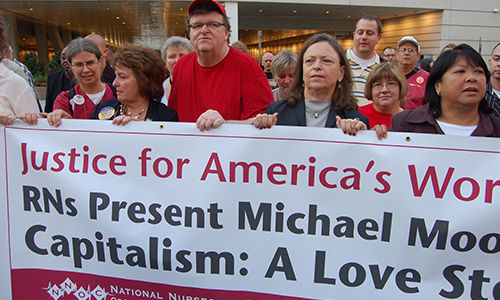
On the year anniversary of the collapse of Lehman Brothers, filmmaker and slacker hero Michael Moore gave a gift to working America: an explanation of what happened.
In short, capitalism happened.
Moore was invited by the California Nurses Association and AFL-CIO to show his newest movie, “Capitalism: A Love Story,” and lead a march for single-payer health care at the convention here. He accepted and re-arranged his schedule to do it, delaying the planned Los Angeles premiere to Wednesday. But that may give him more press for the LA premiere, because Jay Leno invited him to be on his second show of the new series tonight, after viewing the movie.
Instead of stars parading down the red carpet waving to the paparazzi like with other movie premieres, mineworkers, steelworkers, nurses and lots of other workers and professionals marched with the Academy Award winner demanding health care for all. It was a celebration of, by and for ordinary hard-working people who have odds stacked against them.
It was a movie premiere like no other, for a movie like no other. Moore masterfully splices together the absurdities of free market propaganda with the real life stories of what happens when a whole system is just about “maximizing profit.”
The audience exploded into clapping, or booing and hissing, depending on who was on the screen through out the feature.
The next day Moore sent out this e-mail: “But it wasn’t till last night, at the annual convention of the AFL-CIO in downtown Pittsburgh, PA, that a packed house of rank-and-file union members — plumbers and nurses and steelworkers and 73 other trades — watched the U.S. premiere of our film and, I kid you not, the roof practically came off the place as the credits rolled. I’ve never witnessed, in my 20 years as a filmmaker, such a response to one of my movies. I’m sure the theater management must have been thinking a riot was going to break out. After years of having the crap kicked out of working people of this country, the crowd in Pittsburgh was ready to rumble after watching two hours of cinema that laid it all out about how Corporate America has gotten away with murder. I was profoundly moved by this overwhelming and enthusiastic response. I simply can’t wait to bring this movie to your town and for you to see it! I know you will be shocked and surprised by a lot of what you will see in it. Once again, I’ve set out to show you things the nightly news doesn’t dare show you. There will be some very wealthy men who will not be happy about this film’s release. So be it. It’s a free country, but more importantly, it’s OUR country. It doesn’t belong to the richest 1% who now — are you ready for this — have more financial wealth than the entire bottom 95% of the country combined!! “
Moore chooses to delve into the last 30 years after the rise of Ronald Reagan and the far-right, corporate crowd which went to town privatizing, deregulating and cutting taxes for the super-wealthy. Moore shows production and profits skyrocketing, while jobs are cut and wages are frozen.
Cutting away to his 1989 Roger and Me, he has GM executive saying they will cut all the jobs for the company’s health. Guess that strategy didn’t work too good.
But it’s the irresponsible Bush administration and the inevitable global financial and housing collapse in September last year that is at the heart of the movie. The rush for a $700 billion bailout for the largest banks and financial institutions in the country is rightly portrayed as a well-planned heist by these liars, thieves and vultures.
Moore doesn’t hold back in implicating the Congressional Democratic leadership in enabling the grand theft. Ninety-five percent of the movie places the blame for the current crisis on Republican policies and their marriage with major corporate and Wall Street interests in government.
But Moore reserves the rest of the criticism for Robert Rubin of Citigroup and the Clinton administration push for privatization and deregulation under the name of free trade. Rubin along with his acolytes, economic adviser Larry Summers and Treasury Secretary Tim Geithner, both Obama appointees, are all implicated in the economic meltdown.
This is a major point of unease for those on the left and progressive movement. But as socialist and Washington Post columnist Harold Meyerson points out, FDR had some pro-Wall Street advisers around him as well. And like Moore, Meyerson emphasizes the importance of a mobilized progressive grassroots movement. “Where are we?” Moore asked the crowd.
Yet Moore has a dramatic scene about how the election of President Barack Obama has ushered in a whole new era for working people.
Moore does some excellent expose journalism. Bringing to life some of the stories that don’t make national news night after night. Like Blue Chip corporations taking out life insurance policies on employees to enrich themselves when they die, but not the family. In teary-eyed segments, Moore interview families who lost loved ones while Wal-Mart or other corporations collect on their deaths. (And judges being paid to send teenagers to a private, for-profit juvenile detention center.) That’s capitalism!
On the other end are the struggles of ordinary people to fight back. From fighting foreclosures in Miami and in Congress to the sit-in at Republic Windows and Doors and the election of Barack Obama, the movie points to a way for working America to win dignity and economic democracy. Seeing on the big screen real life examples of workers in Wisconsin and California running businesses as cooperatives impresses the point: the dog eat dog model of corporate and casino capitalism isn’t the only way to run an economy.
Moore has a way of Americanizing radical and socialist ideas, something that corporate America and anti-worker forces propagandize as “foreign” and “alien” to the U.S. experience. Yet, as Moore shows, the ideas of cooperation and solidarity, or the distrust of banks are as American as apple pie. Moore weaves together key pillars in American life, religion and patriotism, and reclaims them from the far-right and other hypocrites who proclaim the holiness of the free enterprise system. By looking at American history and its institutions, the film and exposes that radical pro-people and socialist ideals are throughout the fabric of America.
There is a major omission in the film. As Moore sets up the glory days of U.S. capitalism in the 1950s and 1960s, showing home movies of family vacations and narrating about workers who entered the middle class, there was no mention of what was going on at the same time. That millions of Americans were locked into poverty and racial apartheid throughout the South and northern cities. This was a perfect opportunity to show the underbelly of an economic, social and political system that still had deep flaws even when parts of the working class did enter the “middle class.”
Plus, U.S. slavery and taking of lands from Native Americans and Mexico — and the racial theories and policies that ensued to justify it — are central to, as Karl Marx and W.E.B. Du Bois put it, “the rosy dawn of capitalism.”
It was surprising since Moore had gone into some of this in Bowling For Columbine. Moore does include stories of African American and Latino families along with white families, which leave the viewers with the notion that we are all in the same boat. And towards the end of the film, Moore shows clips of the Civil Rights movement, the huge crowds for Obama during the elections and the multi-racial workforce at Republic Doors and Window who heroically stood up to their employer and Bank of America in December 2008.
For history buffs and serious students of American politics, Moore offers a newly discovered gem. His crew found never before seen footage of President Franklin Delano Roosevelt outlining a second Bill of Rights which would include a right to a job, right to health care, housing and education, the right of businesses to operate without the constraints of big monopoly and bank pressures.
Moore said FDR, after giving his last speech to the American people on the radio, called in the film crew to shoot him outlining such a far-reaching plan. FDR was ill at the time and died soon after. Moore’s crew tracked down the film sitting in some unmarked box in South Carolina, Moore said.
At the rally before the march to the Byham Theater, California Nurses Executive Director Rose Ann DeMoro, Mineworkers President Cecil Roberts, Steelworkers President Leo Gerard and Professional and Technical Engineers President Greg Junemann fired up the crowd.
To the cheers of the packed ballroom at the David Lawrence Convention Center, Roberts, a sixth-generation coal miner and orator in the West Virginia-style of rousing speeches, asked the crowd: When George Bush or Joe Wilson gets sick, who pays? When ugly Dick Cheney gets sick, who pays? The crowd shouted: We do! The American people want the same deal, Roberts said.
An extended standing ovation greeted Moore after the movie showing. He took questions from the audience. One was on the distribution of the film. Something, he said, he is always worried about his movies getting picked up. But judging the reception it got by this working class audience, there may be money to be made by exposing capitalism, a good motivation for distributors to pick up this movie.
But for Moore, this movie is certainly a love story — a love affair with the power and strength of ordinary American people to make positive change in our country and world.

MOST POPULAR TODAY

Zionist organizations leading campaign to stop ceasefire resolutions in D.C. area

High Court essentially bans demonstrations, freedom of assembly in Deep South

U.S. imperialism’s ‘ironclad’ support for Israel increases fascist danger at home


UN warns that Israel is still blocking humanitarian aid to Gaza






Comments